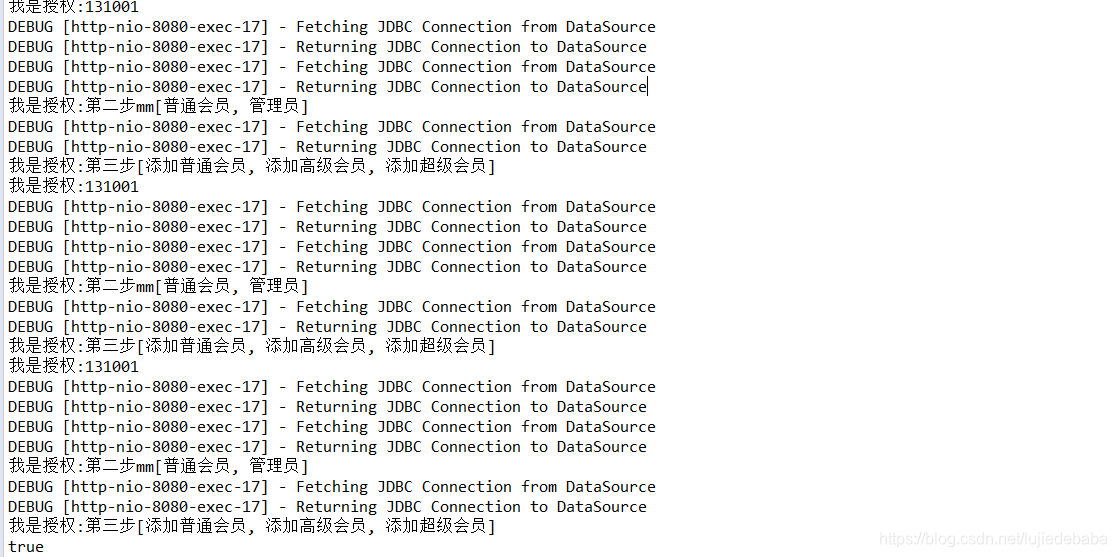第一 、配置 xml 文件
认证 Authentication
第二、controller层 建立factory,初始化
Factory<SecurityManager> factory = new IniSecurityManagerFactory("F:\\SoftwareInstall\\Eclipse\\workSpace\\shiro\\src\\main\\resources\\shiro.ini");
SecurityManager sm = factory.getInstance();
SecurityUtils.setSecurityManager(sm);
Subject subject = SecurityUtils.getSubject();
F:\\SoftwareInstall\\Eclipse\\workSpace\\shiro\\src\\main\\resources\\shiro.ini 为shiro.ini的绝对地址或相对地址。
shiro.ini代码:
[main]
userRealm=com.nt.realm.UserRealm
# 定义凭证匹配器类
credentialsMatcher =org.apache.shiro.authc.credential.HashedCredentialsMatcher
# 设置加密算法
credentialsMatcher.hashAlgorithmName=md5
# 迭代次数
credentialsMatcher.hashIterations=2
# 引用凭证匹配器
userRealm.credentialsMatcher=$credentialsMatcher
securityManager.realms=$userRealm
第三、传入登录输入的名字和密码
UsernamePasswordToken token = new UsernamePasswordToken(u.getUsername(),u.getPassword());
第四、调用subject.login. 作用是:调用自定义的realm类,传入登陆的名字在数据库查询。在底层(不可见)自行对密码验证。(坑,传入的密码会先加密后(在shiro.ini里设置加密)与数据库的密码匹配,即如若加密,则数据库的密码是被加密好的,不然报错)
2、subject.login(token)此步调用认证和授权两步,
3、subject.hasAllRoles(list),subject.isPermittedAll(“添加普通会员”,“添加高级会员”,“添加超级会员”); 各调用一次realm 授权方法
try {
subject.login(token);
//User us = (User) subject.getSession();
System.out.println("登录成功");
List<String> list = new ArrayList<String>();
list.add("管理员");
list.add("普通会员");
System.out.println("456123"+subject.hasAllRoles(list));
System.out.println(subject.isPermittedAll("添加普通会员","添加高级会员","添加超级会员"));
mav.addObject("status","恭喜您登录成功!!!");
return mav;
} catch (UnknownAccountException e) {
System.out.println("账户不存在");
} catch (IncorrectCredentialsException e) {
System.out.println("密码错误");
}
第五、执行自定义realm,代码如下,应在第四步前,贴出来方便大家理解
@Override
protected AuthenticationInfo doGetAuthenticationInfo(AuthenticationToken token) throws AuthenticationException {
// TODO Auto-generated method stub
// 获取需要验证的用户名
String username = (String)token.getPrincipal();
System.out.println("realm第一步:"+username);
// 查询数据库中是否存在该用户名
User user = this.userService.getUserByUserName(username);//查出数据
System.out.println("realm第二步:"+user.getUsername()+","+user.getPassword());
if (user!= null) {
// 存在
SimpleAuthenticationInfo simpleAuthenticationInfo = new SimpleAuthenticationInfo(user.getUsername(), user.getPassword(), getName());
return simpleAuthenticationInfo;
}
// 不存在
return null;
}
授权(角色和权限) Authorization
/**
* 为当前登录的用户授予角色和权限
* @param principalCollection
* @return
*/
@Override
protected AuthorizationInfo doGetAuthorizationInfo(PrincipalCollection principalCollection) {
// 获取需要授权的用户名
String username = (String) principalCollection.getPrimaryPrincipal();
System.out.println("我是授权:"+username);
// 创建授权对象
SimpleAuthorizationInfo authzInfo = new SimpleAuthorizationInfo();
// 查询当前用户名角色并授权
authzInfo.setRoles(this.userService.getRolesByUserName(username));
System.out.println("我是授权:第二步mm"+this.userService.getRolesByUserName(username));
// 查询当前用户名权限并授权
authzInfo.setStringPermissions(this.userService.getPermissionByUserName(username));
System.out.println("我是授权:第三步"+authzInfo.getStringPermissions());
return authzInfo;
}
:权限分配应该由前台来实现,将可操作的按钮和链接等组件隐藏,shiro只要将查到的权限名返回给前台,前台的组件与权限名绑定,让组件显示或隐藏。




 本文详细介绍了使用Apache Shiro框架进行权限认证的具体步骤,包括配置XML文件、初始化SecurityManager、登录验证、角色与权限授权,以及自定义Realm的实现过程。
本文详细介绍了使用Apache Shiro框架进行权限认证的具体步骤,包括配置XML文件、初始化SecurityManager、登录验证、角色与权限授权,以及自定义Realm的实现过程。
















 862
862

 被折叠的 条评论
为什么被折叠?
被折叠的 条评论
为什么被折叠?








